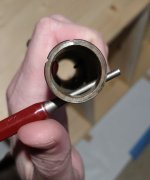redlightrich
New member
Hello all, I can't find the exact written passage in regards to making a muzzle brake permanent.
I realize that common practice is to drill a divot in the threads of the barrel, add a steel pin and weld it closed.
An agent with a wrench should not be able to remove it.
What if the hole thru the muzzle brake was filled with a pin then closed with steel mixed epoxy? It also would require special tools to remove. It would be permanent to most individuals without special equipment.
Does the law require welding specificaly or do they vaguely state permanently attached?
I own a mig, gas and arc welder. I am basically trying to understand the law. This is from a NJ perspective.
Thank you
Rich
I realize that common practice is to drill a divot in the threads of the barrel, add a steel pin and weld it closed.
An agent with a wrench should not be able to remove it.
What if the hole thru the muzzle brake was filled with a pin then closed with steel mixed epoxy? It also would require special tools to remove. It would be permanent to most individuals without special equipment.
Does the law require welding specificaly or do they vaguely state permanently attached?
I own a mig, gas and arc welder. I am basically trying to understand the law. This is from a NJ perspective.
Thank you
Rich

